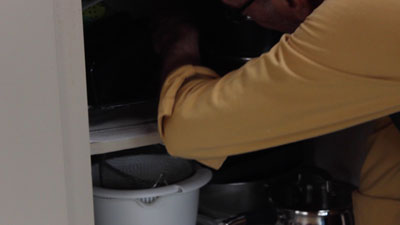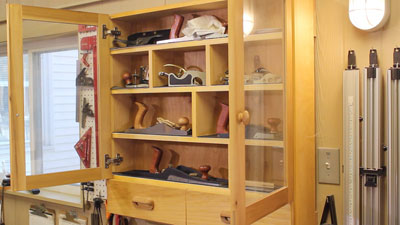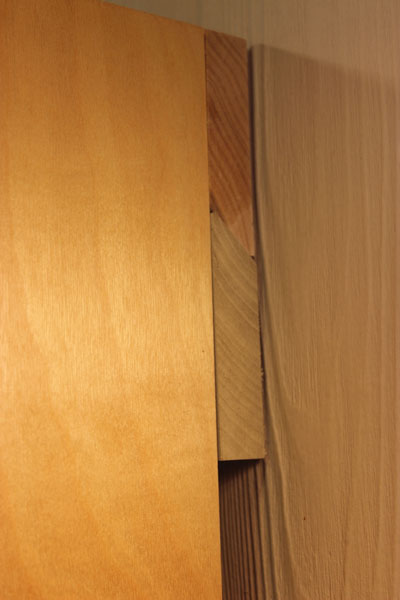
 by Steven D. Johnson
by Steven D. Johnson
Racine, Wisconsin
(Page 3 of 3)
Previous Page
1
2
3
The 5S Compliant Shop Wall Cabinet
In our adaptation of 5S to the woodworking shop, we know that cabinets will "self arrange" --- the things we use most often will be in the front and the things we use rarely will migrate to the back. Most of the time those things in the back of the cabinet are forgotten, lost, or not really needed. So why do we keep them? Which leads us to the next inevitable question, why do we make our cabinets so deep?

|
|
Figure 7 - How do you find anything in the back
of a deep dark cabinet like this?
|
Habit or convention may explain our overly deep cabinets. Twenty-four inch deep base cabinets and twelve-inch deep wall cabinets are kitchen "standard." Yet my favorite cabinet in the shop is the one I built to hold my hand planes. It is just over six inches deep (five inches inside), and my planes cannot migrate to the back… they are always in the front, easy to grab, easy to replace. It seems logical then that custom built cabinets, with a depth tailored to the items they will hold, would save a lot of space in the shop, help keep things "5S organized," and stop us from collecting "junk" that gets in the way and will never be used.

|
|
Figure 8 - This cabinet is "close" to ideal -
but it's not perfect
|
To test the hypothesis, I decided to first replace the cabinet that holds my safety and first aid equipment. Its current depth makes it difficult to find small items and not knowing what lurks in the deep recesses of the cabinet has caused me to buy things I didn't really need and to hoard things that were no longer relevant. When cleaning out the cabinet I found replacement filters for a mask I no longer have… go figure.
Of course everyone should know where safety and first aid supplies are located, and even a visitor should be able to find the items quickly. As a system of shop organization, 5S relies heavily on visual cues. Building a safety supply cabinet with clear doors will make it easy for anyone to find what they need quickly.
Where the cabinet is currently located is okay, but the depth gives me a feeling of claustrophobia and it gets in the way when I sometimes store a piece of equipment in that general area. All in all, it is a great candidate for my first "5S Compliant" cabinet replacement.

|
|
Figure 9 - The French cleat wastes 3/4"
of space...seems small, but why waste
the space?
|
My initial step was to outline a list of "5S Compliant" design criteria. It is really a pretty straightforward list:
1. Front-to-back depth matches what will be stored (1 layer, nothing hidden).
2. Doors made with clear fronts (acrylic).
3. Configurable (or reconfigurable) interior.
4. Drawers (if any) must have easy and full access.
5. French cleat mounting, but without the usual wasted space.
Item number 5 may seem picayune, or, as a good friend used to say, "Like picking the fly poop out of the pepper." But it really annoys me that a 3/4" board on the back of a cabinet cut with an angle to match my French cleats actually wastes 3/4" of depth. The photo explains this a little better.
With the basic design criteria in mind, the next step was to determine the final depth, and to some extent, the layout of the interior. Doing that turned out to be pretty easy. I used blue painter's tape on the floor to mark out a rectangle the size of the intended cabinet. Then I stacked everything within that square as if it were in the cabinet. With that done, I measured the height of the tallest items to determine the minimum cabinet depth. It turns out that my current twelve-inch deep cabinet can be replaced with one only about half as deep, or about 6 – 7 inches. My final design will key off of the necessary interior depth and the style of construction will dictate the overall depth.
......
This month's video
, the first in a series, covers the design criteria, the choice of materials, and overall construction techniques that will be used for my "5S Compliant" wall storage cabinets. The idea is to create a design that anyone can adapt to the depth they need for the items they want to store.
CLICK HERE
to watch it.
The mid-month video will cover the construction of the cabinet carcase and more, then Part 3 will cover the making of the see-through doors.
......
Next month, we will wrap up the sticky subject of tapes with test results. We will also learn which tapes our testing shows are currently the best for our woodworking needs. See you soon!
......
Thinking about dust collection? Be sure to mark March 25 on your calendar because I will be hosting a new Popular Woodworking live webinar presentation
"Choosing and Using a Dust Collection System."
I will cover dust collection machinery, how to pick the best machine for your shop, and how to install it for maximum efficiency. Watch your email and the
Highland Woodworking Blog
for news about how to sign up for this important class.
(Page 3 of 3)
Previous Page
1
2
3
Steven Johnson is retired from an almost 30-year career selling medical equipment and
supplies, and now enjoys improving his shop, his skills, and his designs on a full time basis
(although he says home improvement projects and furniture building have been hobbies for most of his
adult life).
Steven can be reached directly via email at
downtoearthwoodworks@me.com
.
Return to
Wood News
front page

